The Influence of Lighting Fixtures in Poker Rooms
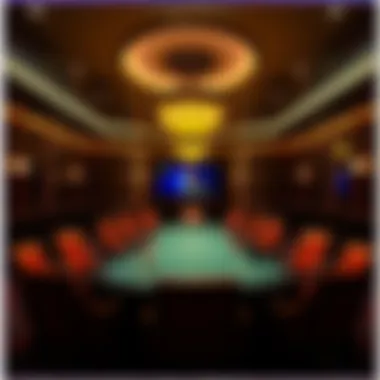
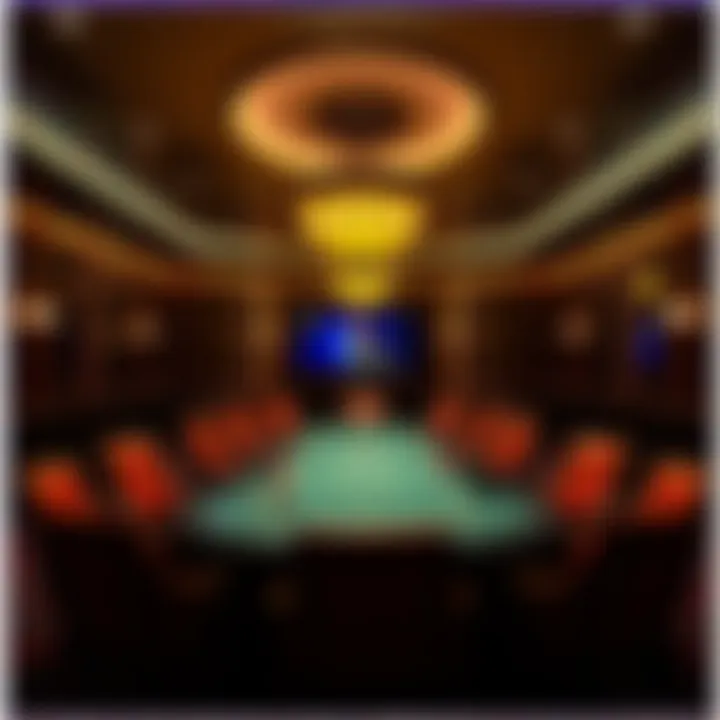
Intro
When stepping into a poker room, one might think the main focus lies on the chips, cards, and the players themselves. However, the lighting fixtures often play a hidden yet pivotal role in shaping the overall game experience. From setting the mood to influencing how players interact, the right kind of light can transform a standard poker setting into an enthralling atmosphere. Many don’t realize the subtle dance between light and shadow, nor how it can sway their decision-making process during those high-stakes moments.
Lighting isn’t just about visibility; it’s about perception. The lights can create drama, focus attention, and even raise the stakes by amplifying tension. For example, consider an intense poker face illuminated by the intense glow over the table. This can either heighten excitement or create pressure, depending on the context.
In this article, we will delve into the myriad ways lighting influences gameplay and the ambiance within poker rooms. By dissecting various lighting types, design elements, and even the psychology behind light’s effects, we aim to provide a comprehensive insight into how these factors contribute to the overall gaming experience.
Our journey will navigate not only the practical aspects such as types of lighting like overheads or dimmable fixtures, but also dive into the mood-related nuances that create an ideal environment for players. Understanding these elements is critical for anyone who wants to elevate their game, deepen their appreciation, or even design their own poker environment.
With that said, let's get ready to flip the switch on our understanding of poker room lighting.
Understanding Poker Room Environment
The ambiance of a poker room is not merely a backdrop; it's an integral element that shapes the gaming experience. It creates an atmosphere where every hand dealt is wrapped in a cocoon of excitement and tension, influencing how players feel, think, and act. This section aims to shine a light on the importance of crafting an environment that perfectly balances both practical and aesthetic components, ensuring that players are engaged not just in the game, but in the experience itself.
Importance of Ambiance
The ambiance within a poker room speaks volumes to the players. Think about it: the moment one steps through those doors, a mix of sounds, sights, and smells welcomes them. Dimming lights can often create an intimate feel, lending an air of secrecy and anticipation to the game. Color palettes play their part too; deep reds and rich greens can evoke feelings of wealth and luck. Ambient music, when used, can soothe or energize, depending on what the room aims to achieve.
In this high-stakes environment, the right ambiance can encourage players to stay longer and, crucially, to spend more. It’s not about flashy neon signs or brightly lit panels, but instead finding a harmony that keeps players comfortable yet alert. By managing the ambiance effectively, rooms can foster a sense of belonging, making players feel that they are part of something grand where every moment counts.
Role of Lighting in Game Dynamics
Lighting is arguably one of the most potent tools in setting a poker room’s dynamics. The type and intensity of lighting can drastically affect a player’s ability to focus and make critical decisions. For example, a brightly lit table might invite discussion and camaraderie, while softer lighting can lead to more serious, contemplative play.
- Visibility: Players need to see their cards and chips clearly without straining their eyes. A combination of task lighting—direct light focused on the gaming area—alongside general lighting helps in achieving this.
- Distraction Minimization: Bright, harsh overhead lights can lead to distraction and discomfort. A thoughtful lighting scheme can control glare and ensure that players remain focused on the game ahead, rather than the environment surrounding them.
- Tabletop Illumination: Having adjustable lights over tables allows dealers and players to maintain control over their environment. Players can tweak the brightness to their liking, leading to more confident decisions.
Lighting influences how players perceive their surroundings and interact not only with their cards but also with fellow competitors. The dynamics of each game can change subtly based on the lighting conditions, which is why it becomes an element that deserves careful consideration when designing a poker room.
“Lighting is not just about visibility; it sets the mood and affects how players engage with the game.”
Types of Lighting Fixtures
Understanding the various types of lighting fixtures is pivotal in creating the ideal environment within poker rooms. Each type serves a distinct purpose and contributes to the overall atmosphere, which can either heighten or dampen the gaming experience. By recognizing how different lighting styles play off one another, one can tailor a room that not only looks appealing but also enhances the strategic elements of poker playing.
General Lighting
General lighting, often referred to as ambient lighting, serves as the foundation of a room's illumination. This type of lighting ensures that players can navigate the space comfortably, providing a uniform level of brightness without any harsh shadows. Think of it like a warm embrace that invites players to settle in and concentrate.
- Fluorescent Ceiling Lights: Commonly used in many establishments, these fixtures provide a broad spread of light. However, without tinted covers, they can at times create a sterile feeling that might not be conducive to an exciting poker game.
- LED Panels: More energy-efficient than fluorescent options, LED panels offer versatile color temperatures that can enhance mood. Players may appreciate the softer lighting that promotes a relaxing atmosphere, which can help reduce pressure during critical decision-making moments.
General lighting acts as a mainstay in any poker room, striking a balance between visibility and comfort. It sets the stage for the finer details that follow.
Task Lighting
Next up is task lighting, which can be thought of as the spotlight of the poker room. This style is crucial for providing focused illumination where it is most needed: around the poker tables. Its primary role ensures that players have adequate light to read cards, chips, and other essential game elements without straining their eyes.
- Table Lamps: Stylish and functional, these lamps add elegance while maximizing visibility. They can even feature adjustable arms, letting players customize their lighting as per their preferences.
- Under-table Lighting: This innovative approach casts a glow directly onto the game surface, illuminating cards and chips without spilling light into other areas of the room. This way, players focus solely on the game at hand.
With effective task lighting, attention is drawn toward the game while providing adequate visibility, enabling players to make skilled moves.
Accent Lighting
Accent lighting can often be overlooked but it plays a significant role in creating a memorable poker room. This type highlights specific features or design elements, adding depth and interest to the environment.
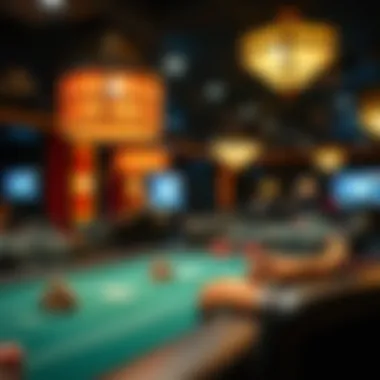
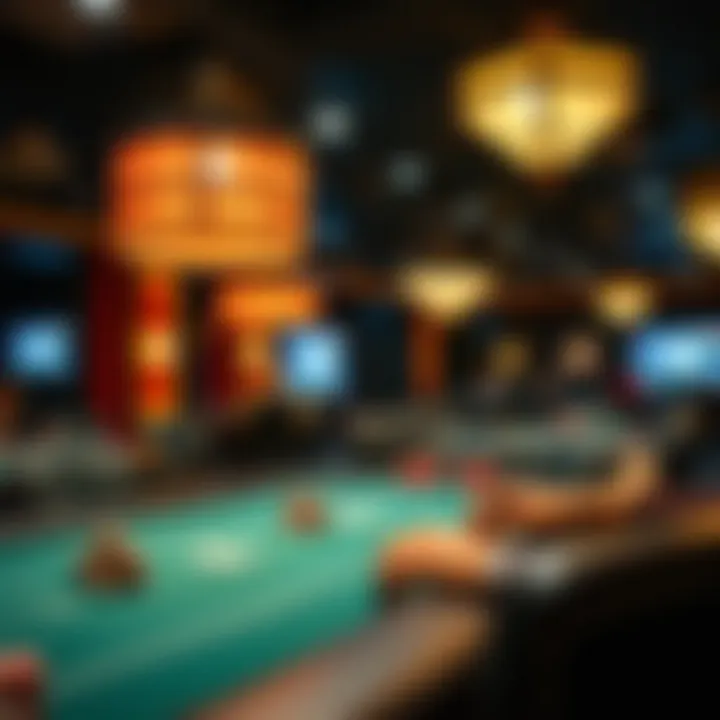
- Wall Washes: By casting light onto the walls, this technique can create a sense of space and comfort. It can also draw attention to artwork or branding that might be present, subtly enhancing the aesthetic appeal without being too obtrusive.
- Spotlights: These can be strategically placed to illuminate impressive design elements or even be directed towards landmark tables where significant events have taken place, adding a touch of history and character to the room.
Patterned shadows from accent lighting create a dynamic atmosphere that captivates players, fueling the ambiance as they engage with the game's social and strategic aspects.
Ambient Lighting
Ambient lighting encompasses a broader concept, usually blending general and accent lighting. It's about creating the overall mood within the poker room. It often considers non-intrusive options allowing for a layered effect, making it feel both welcoming and exciting.
- Dimmable Fixtures: These are critical if a room needs to adjust according to the time of day, ensuring it can switch from a bright, lively environment to a more subdued setting as the game intensifies.
- Color-Adjustable Fixtures: With the ability to change colors, these fixtures can set different moods, perhaps using warmer tones during relaxed sessions or cooler tones for high-stakes tournaments.
The beauty of ambient lighting lies in its adaptability; it can shift in response to the players’ emotional currents, further deepening the immersive experience of the poker table.
"In the world of poker, lighting is not just about visibility; it shapes the experience and influences decisions at the table."
Grasping the intricacies of these types of lighting fixtures helps in creating an engaging atmosphere that enhances gameplay, positively affecting the players and their experience.
Design Considerations for Poker Room Lighting
When it comes to poker rooms, lighting plays a crucial role that goes beyond mere functionality. It's not just about seeing the cards clearly; effective lighting influences mood, supports game dynamics, and ultimately enhances the overall experience. A well-thought-out lighting design can attract players, creating an inviting atmosphere while also aiding in the strategic aspects of the game. Very few people consider how lighting affects their decisions at the table, yet it's fundamental to the environment in which they’re playing.
Color Temperature
Color temperature is a significant factor in a poker room's lighting strategy. Simply put, it refers to the hue of the light emitted by a bulb, measured in Kelvin (K). Lower temperatures (around 2700K) emit a warm, yellow light, similar to incandescent bulbs, creating a cozy and relaxed setting. Conversely, higher temperatures (like 5000K) produce a cooler, bluish light that can feel stark and clinical but also promotes alertness.
Finding the right balance is essential. Too much warmth might make players lethargic, while an overly cool atmosphere can generate tension, possibly leading to hasty decisions. In a high-stakes game where every move counts, maintaining a comfortable color temperature helps keep players engaged and focused. It’s not just about aesthetics, but about ensuring that emotions and concentration are influenced positively.
Fixture Placement
Where you place the lights can change everything. Proper fixture placement helps control shadows while also emphasizing key areas such as the poker table, ensuring that players can see their cards without glare. Overhead fixtures are standard, but their positioning should take into account the angle of light to minimize harsh shadows or hotspots on the table.
Consider also using wall sconces or floor lamps as additional lighting points. These can provide atmospheric light without directly affecting the players' ability to see. For example, subtly placed fixtures that highlight decor can draw attention to the overall theme of the room, enriching the player’s experience without being distracting. Strategic lighting can create a sense of intimacy or drama—two vital emotions casinos wish to evoke.
Light Layering Techniques
Layering light involves combining different types of lighting—general, task, and accent—to create a balanced atmosphere. A poker room can greatly benefit from this technique. General lighting provides overall illumination, while task lighting focuses on specific areas where players need clarity, like the table itself. This is where pendant lights or focused downlights come into play, creating a bright zone centered on the game.
Additionally, integrating accent lighting can enhance features like artwork and architectural details, giving the room its unique flair. Using light layering can elevate the room from a simple gambling space to an engaging venue where every detail is a part of the experience. Not only does this cater to the practical needs of players, but it also enhances the psychological aspects of gameplay.
Ending
Designing the lighting in a poker room is more than just about illumination; it’s about creating an environment where players feel comfortable, engaged, and emotionally connected to their surroundings. By paying attention to color temperature, fixture placement, and light layering techniques, casino managers can significantly enhance not only the aesthetic but also the psychological effects that lighting has on players' experience at the table. Lighting is an unsung hero in creating the perfect poker gaming atmosphere.
Psychological Effects of Lighting
In poker rooms, the significance of lighting extends far beyond mere visibility. It shapes the overall atmosphere, creating intense environments where every decision counts. The psychological effects of lighting are deeply intertwined with the player's mindset, mood, and ultimately their performance. Properly designed lighting contributes significantly to the gaming experience, enhancing emotions and the engagement within the room. Let's explore the nuances of this aspect in more detail.
Impact on Player Mood
Lighting has a profound ability to influence emotions. In a poker room, the right kind of illumination can evoke feelings of comfort and excitement or create tension and uncertainty. The color and intensity of light play a vital role in this emotional equation, often shaping the player's perception of their surroundings. For example, warm light can create a cozy and inviting atmosphere, making players feel at ease as they engage in a game, while cooler tones can inject a sense of urgency or alertness.
- Soft lighting makes the space feel intimate, ideal for social interactions and casual play. This type of ambiance encourages communication and camaraderie among players, which can be beneficial, particularly in tournaments where alliances and camaraderie are formed.
- Conversely, harsh, direct lighting can heighten anxiety levels. If players feel scrutinized under bright overhead lights, this can negatively affect their comfort, causing them to second-guess their strategies.
It’s essential to strike a balance; utilizing varied lighting styles can cater to different emotions and play styles, thus enhancing the overall gaming experience. In essence, the way light interacts with the space and players can either lift spirits or weigh heavily on decisions made at the table.
Influence on Decision Making
The mental game of poker requires a blend of strategy and psychology. The surrounding lighting can have a substantial impact on how players process information and make crucial decisions. Research indicates that different lighting conditions can affect cognitive functions, including reaction times and memory recall.


In darker environments, players might feel more relaxed, resulting in slower decision-making. This can lead to more cautious play, as individuals take time to assess situations. However, this is a double-edged sword, as too little light can also impair visibility, leading to potential mistakes. On the other hand, brightly lit spaces tend to stimulate alertness. Players may experience increased heart rates and heightened senses, which could accelerate their decision processes and risk tolerance.
A few key points regarding lighting and decision-making include:
- Bright light may foster a more aggressive play style as players feel more energized and willing to take chances.
- Soft, ambient light might promote careful calculations, making players ponder each move more critically.
- Shadows and contrasts can also influence how players perceive their opponents, as well as the atmosphere of the game itself.
"A simple change in lighting can shift the entire mood of a poker session, affecting both the joy of play and the rationality of decisions, impacting the outcomes significantly."
Technological Innovations in Lighting
The world of lighting has seen remarkable strides in recent years, especially within the context of poker rooms. As players spend hours engaged at the tables, the role of lighting fixtures extends beyond mere visibility. They contribute significantly to the atmosphere and overall experience. As technology evolves, poker room lighting adapts, enhancing not just aesthetics but also functionality.
Smart Lighting Solutions
Smart lighting has carved out a niche in various settings, poker rooms being no exception. These systems allow operators to control lighting remotely via smartphones or dedicated panels. This versatility can transform the ambiance with just a few taps — imagine dimming the lights during high-stakes moments or shifting the color temperature to invigorate energy at the tables. Developers are integrating sensors that automatically adjust brightness based on natural light levels or even player preferences, creating a customized experience.
Moreover, smart lighting can play a vital role in energy efficiency. Given the often prolonged hours of operation in poker rooms, integrating smart solutions not only helps create the right mood but also slashes energy costs significantly. Installing solutions from companies like Philips Hue can lead to savings while providing optimal lighting that can keep players engaged for longer.
LED Lighting Benefits
LED lighting represents a significant leap forward in technology compared to traditional incandescent bulbs. One standout advantage is the discrepancy in energy consumption. LEDs require substantially less power for the same output, translating to cost savings and a reduced carbon footprint. This is especially useful for poker rooms buzzing with activity. With the consistent flickering of chips and the laughter of players, stability in lighting becomes crucial.
Lighting fixtures that use LED technology also offer longer lifespans compared to their counterparts. This durability translates to fewer replacements and lower maintenance costs, allowing poker room operators to focus their resources elsewhere. Furthermore, LEDs are less prone to heat, ensuring that players stay comfortable, even in high-pressure and crowded environments.
In addition to practicality, the quality of lighting can significantly influence player experience. LEDs render colors more vibrantly, creating a warm and inviting atmosphere—perfect when seeking to encourage players to stay a little longer and indulge in one more hand.
"Lighting is not just about illumination; it’s about creating a feeling and sustained engagement that draws players in."
As technology progresses, it’s clear that innovations in lighting will continue to shape the poker room experience. With smart lighting solutions meshing seamlessly with LED efficiency, the future of poker room lighting is bright, providing a backdrop that not only enhances gameplay but also contributes to the overall excitement and energy that defines these spaces.
Historical Context of Poker Room Lighting
The journey of lighting in poker rooms reflects a fascinating intertwining of culture, technology, and the evolution of player experience. Understanding this historical context sheds light—pun intended—on how lighting choices impact not just the aesthetic, but the very atmosphere and functionality of these spaces. Historical trends in lighting illustrate a narrative of adaptation; from flickering gas lamps to cutting-edge LEDs, each era has brought forward innovative solutions that redefined how poker rooms are perceived and experienced.
Evolution of Lighting in Casinos
In the early days of casinos, lighting was largely utilitarian. Oil lamps and gas fixtures were the norms, providing essential visibility rather than ambiance. As gambling establishments began to transition from simple venues to elaborate entertainment hubs, the approach to lighting altered significantly. The mid-20th century heralded the introduction of neon signs and vibrant colors, which captured the excitement of the gambling world. The introduction of electric lighting brought a sea change, allowing design possibilities previously unimagined.
As casinos evolved, the focus on creating an immersive experience took precedence. For example:
- 1940s to 1970s: This period saw the rise of lavish designs; chandeliers adorned ceilings, and dramatic spotlights illuminated tables. This setup wasn't just for aesthetics; it encouraged patrons to feel enveloped in a world of elegance and thrill.
- 1980s: The advent of themed casinos brought about specialized lighting. Here, the lighting became a narrative tool, linking visual experiences with thematic elements. For instance, a pirate-themed casino was often replete with dim, moody lighting to evoke the feel of a treasure cave.
- 1990s onwards: Smart technologies began to find their way into the casino lighting landscape. Programmable lights allowed for varied intensities and colors throughout different times of the day or night, enhancing the gaming experience.
With every technological leap, the evolution of casino lighting sought to capture player engagement, reflecting the changing paradigms of societal preferences.
Cultural Influences on Lighting Design
The cultural context of poker room lighting is equally vital, as lighting choices often mirror societal trends. Different regions and their distinct heritage influence how lighting is implemented. For instance, in Las Vegas, where the desert sets a stark backdrop, bright and bold lighting is a decision made to stand out against a largely subdued natural landscape. Conversely, poker rooms in places like Monte Carlo embrace more subdued and elegant lighting that draws on tradition and opulence.
Key cultural influences include:
- Regional Heritage: Cities with a rich history often reflect their roots in the lighting styles adopted. For example, a poker room in New Orleans might utilize hanging lanterns reminiscent of its French heritage.
- Cultural Symbols: Lighting can convey deeper meanings within different communities. Bright colors may resonate with celebratory cultures, while subdued hues are favored in cultures that value tranquility and focus during gameplay.
- Artistic Movements: Lighting design can also be a product of local artistic movements, wherein styles symbolize broader design philosophies embraced by society.
In sum, the historical context of poker room lighting represents a continual evolution shaped by technological advancements and cultural narratives that create not just a functional gaming environment but a rich visual tapestry that impacts how players interact with the space around them.
Case Studies
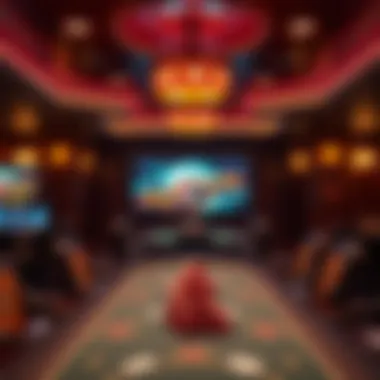

Exploring real-world examples provides great insight into how lighting shapes the atmosphere in poker rooms. These case studies highlight the significant trends and patterns that can guide future designs, offering a lens into how lighting can enhance or detract from both enjoyment and serious gameplay. Examining specific cases also sheds light on the psychological impact of light on player behavior, making this exploration invaluable for casino designers and operators alike.
Notable Poker Rooms and Their Lighting
In the realm of high-stakes poker, the ambiance is everything. Let’s look at some well-known poker rooms that have masterfully utilized lighting to create engaging environments.
Bellagio, Las Vegas
The Bellagio’s poker room features luxurious overhead chandeliers that cast a warm golden glow over the tables. This lighting not only embellishes the opulence of the casino but also allows players to maintain focus and comfort. The combination of general lighting with softer accents on the tables creates an inviting but competitive environment. The clever use of dimmable LEDs ensures that strong lighting doesn't distract players from reading their opponents’ expressions, crucial in a game where every tiny detail matters.
The Commerce Casino, Los Angeles
This poker haven utilizes multiple types of lighting aimed directly at enhancing gameplay. Task lighting is prominent, illuminating each table to give players the clarity they need to sort chips and read cards. Additionally, accent lighting around the room's décor helps anchor the sense of place while steering clear of overwhelming glare. The room is designed to accommodate both casual players and serious contenders, making every participant feel comfortable enough to engage fully.
Crown Casino, Melbourne
Crown Casino incorporates ambient lighting extensively. Floating panels and LED strips line the floors and ceilings, creating a futuristic atmosphere. This method provides an immersive experience that visually connects the players to the spaces around them. The blend of purple and blue hues injects a certain vitality into the poker room. Studies have shown that such colors can promote a calm, focused mindset—valuable traits when the stakes are high.
“Light is the key perishable in decision-making; too much can blind, while too little can obscure.”
Comparison of Lighting Styles Across Themed Rooms
Diving into various themed poker rooms reveals how lighting styles align with the overall concept while influencing player dynamics. Let’s examine a few examples:
- Classic Charm: In vintage or retro-themed rooms like those echoing Las Vegas’ golden age, warm, incandescent bulbs are often preferred. These don’t just provide light; they weave nostalgia. The subdued glow encourages players to linger, creating an atmosphere where they can savor not just the games but the moment.
- Ultra-Modern: In stark contrast, rooms themed around modern aesthetics often utilize stark white LED lights. This type of lighting can create a sterile atmosphere, yet it emphasizes clarity and speed—ideal for fast-paced card games. In places like the Aria Resort, sleek designs combined with bright, directed lighting create a sense of urgency.
- Cultural Influences: Some poker rooms incorporate lighting styles influenced by cultural motifs. For instance, rooms designed around Asian themes often include lantern-like fixtures that cast colorful patterns on surfaces. It’s not just about illumination; it’s an experience that roots players in tradition while enticing modern interaction.
Evaluating the nuances of lighting in these different themed spaces highlights how essential it is to shape not only the game atmosphere but also player emotional states. Unique fixtures, color choices, and placements can create completely different scenarios, impacting everything from the experience to decision-making during gameplay.
Future Trends in Poker Room Lighting
The landscape of poker room lighting is evolving rapidly, much like the game itself. As technology advances and society places a stronger emphasis on environmental responsibility, the trends in lighting fixtures are adapting to meet these needs. Incorporating innovative lighting solutions not only enhances the aesthetics of the poker room but also boosts player experience and operational efficiency. Thus, understanding these future trends becomes paramount for casino operators and designers alike.
Sustainability Considerations
In today's world, sustainability isn't just a buzzword; it's a necessity. The casinos are taking a serious look at how their lighting choices impact the environment. Energy-efficient fixtures like LED lights have become staples due to their lower energy consumption and longer lifespan. This shift means that operators can save money on electricity bills while also appealing to a growing demographic that values eco-friendly practices.
Moreover, sustainable lighting isn't merely about being kind to the planet. It also influences player perceptions and satisfaction. For instance, when a poker room is decked out with fixtures that draw attention for their energy-efficient design, it can make a good impression. Players might view the establishment as more sophisticated and socially responsible. Here are some sustainability factors to consider:
- Energy-efficient Options: LEDs and eco-friendly bulbs.
- Smart Lighting Controls: Systems that adjust based on occupancy or time of day.
- Recycling Initiatives: A conscious effort to manage old light fixtures properly.
The conversation surrounding sustainable practices is not just for show; it’s about embedding responsibility into the fabric of casino operations.
Integration of Virtual Elements
As gaming moves further into the digital realm, poker rooms are beginning to merge physical and digital experiences through advanced lighting solutions. Imagine entering a poker room where the lighting changes according to the game being played or the action at the table, enhancing the immersive experience.
Virtual elements could be integrated into lighting designs that respond to gameplay. For instance, dynamic lighting could change intensity with the stakes of the game, creating a palpable atmosphere of tension during pivotal moments. The benefits of integrating such virtual elements include:
- Enhanced Atmosphere: Creating a vibrant environment that responds in real time to game activity.
- Viewer Engagement: Players and spectators alike feeling more involved due to reactive lighting.
- Branding Opportunities: Unique light displays can be tailored to specific tournaments or promotions, adding a signature touch.
In summary, the future trends in poker room lighting are leaning heavily towards sustainability and the blending of virtual elements with physical experiences, offering unprecedented opportunities to enhance both gameplay and the overall atmosphere.
Epilogue
In recapping the role of lighting fixtures within poker rooms, it becomes clear that the impact of lighting goes beyond mere illumination. The ambiance created by thoughtfully designed lighting can significantly influence player engagement and overall experience. A well-lit poker room fosters not just visibility but also a connection to the game, setting the mood and framing the action taking place. Considerations like color temperature and fixture placement can craft an atmosphere that encourages social interaction while allowing players to focus on strategies essential to the game.
Summary of Key Points
A few essential elements to take away include:
- Ambiance is vital: It shapes the player's emotional state and can influence their decision-making.
- Different types of lighting serve unique purposes: General, task, accent, and ambient lighting must be utilized in harmony.
- Design considerations play a critical role in maximizing the potential of the space.
- Technological innovations such as smart lighting and LED solutions are transforming how we think about poker room environments.
- Future trends lean toward sustainability and the incorporation of virtual elements, suggesting an exciting evolution in poker room design.
Final Thoughts on Lighting and Player Experience
Ultimately, lighting within poker rooms is not just a trivial concern. It acts as a catalyst for enhancing player experience, combining practicality with atmosphere. The strategic use of varied lighting fixtures can lead to improved alertness and enjoyment, while also promoting a sense of inclusiveness and vibrancy among players. As the world of gaming continues to evolve, understanding lighting’s multifaceted role will become even more paramount. Therefore, those investing in or designing poker rooms should prioritize effective lighting solutions that resonate with the gaming community, establishing an environment where players feel engaged, comfortable, and informed.
"Good lighting is essential; it can be the difference between a great game and a forgettable one."
The future of poker rooms might be dynamic and innovative, but at the heart of it all, lies the importance of well-crafted lighting fixtures that foster a better gaming experience.



